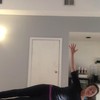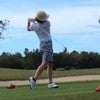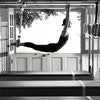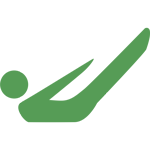Description
About This Video
Transcript
Read Full Transcript
Hi. Thank you for joining me. I'm Meredith. Still. And today, we're gonna do a short reformer class focusing on thoracic mobility and extension. I personally happen to be obsessed with a thoracic extension because it feels amazing in my body.
So you will find those sorts of things in many, many, many of my classes, but today it will be our primary focus. So There is one blue spring attached to the reformer and we can get going. So come around. Stand at the foot bar end of the reformer. Find yourself in your body.
It's worthwhile to just take that moment. Take the arms forward. As they reach up towards overhead, feel the body lifting into the arms. Take the arms around. So even just now, just that little simple extension, it's not big. You're not leaning back or I'm not leaning back.
Instead thinking about holding the lower spine pretty stationary, and extending just through the upper spine. As the arms come towards the reformer, bring the body back into an upright position, and then just begin to articulate down. Rounding down towards the carriage, take the hands onto the carriage elongate through your spine. So pressing out into a nice low flat spine and bend the elbows wide. Just starting to tap into that musculature.
Feel the shoulder blades glide down as the arms reach out to straight, and then around. Bring the reformer back to a stop. Roll through the spine. And what we'll do here is exactly the way we started. So as the body's coming up, just allow the arms to continue up with the body.
Take them around. Feel the chest going forward, not back. About the t position, the arms continue to come down, but start in that forwardly reaching direction head goes down. Round through the spine or aware of it really. Just make it feel natural for you.
I like to wedge my hands in against the edge of the frame, gives me a nice place to push. So lengthening the spine, bend the arms. Keep the elbows in the periphery. So the feeling almost is that the elbows go a little lower than the hands. And then round through the spine, touch in, roll up, continue with the arms. We'll do two more.
Open around. Make it feel natural as the body starts to come down. The arms are reaching into the carriage. Feeling like I'm losing my vocabulary today, reach out. Get long.
The bend of the elbows doesn't come from the hands. It comes from the back. Feel the shoulder blades widen. Feel the shoulder blades go away from the hands as the arms are reaching back overhead and then roll up. Lift up.
Bring the arms up. Take the arms around. This is our very last one. Arms reaching for the frame of the reformer, for the carriage of the reformer, rather. Rolling down, landing, leaning into that flat back, really focusing on that scapular stability, bending the arms, stretching them back forward, rolling the spine up, coming up, bringing the arms up, and open.
So the next thing that we're gonna do is we're just gonna go through a little bit of footwork just to warm up the body the rest of the way. So I'm gonna attach three reds one blue spring. That's my preferred footwork spring. And then we're gonna just roll onto the carriage. Finding the center of the carriage with the center of the body.
Head can be down or up. I kind of like mine up so I can see my feet, and then we're gonna press out and bend in. Just quickly moving through using the larger muscles of the body to get the body nice and warm. Feel that the work is powered first from the abdominals, then from the backs of the legs. So we feel the connection to the center of the body on the exhale breath, We feel the heels pressing into the foot part engaging through the backs of the legs and when the legs are straightening, that's where we can focus on the front of the legs. We're just gonna do two more reach out.
And pull in. Reach out and pull in and come down onto the toes. Take the carriage out all the same ideas and bend. Feel the backs of the legs working as you reach. What you can start thinking about here as we're moving with our legs is really feeling the space between the shoulder blades in the mid back. Now that doesn't mean to me push or squeeze the shoulders together.
It just means thinking into those muscles, pressing down with the arms. Thinking about how we can use our connection to our arms to find our back muscles and pull. So while we're three more not doing any bending of that part of the body in this moment, we can start feeling those muscles working too. And one. Bend and come back in.
External rotate bringing the heels together, toes apart, anchoring the pelvis and reach out and pull in. Reach out. Don't forget about the upper back. So this is valuable anytime, but particularly relevant. To today's idea, today's focus, who are bringing a lot of awareness into that upper back area for keeping the pelvis in neutral.
Noticing that attention to the details in the upper back doesn't cause the back to arch or the ribs to lift. Ribs are soft just the muscles are working too. And in. One. And in, return back to parallel with the legs and reach out and go under and up all the way under.
So stretching those feet, stretching the calves, feeling that same connection to the mid back, feeling that same connection to the softening of the ribs, the activity in the arms, last time, and we alternate. Go up. And up, down, and up meeting in the middle with the legs straight and then alternating sides. We'll do four. And four.
Check back in with the back. Three. And three. Check back in with the ribs too. And two. One.
And one. Come up. Come in. Roll off to the side. And we're gonna change the spring.
I use a blue. The blue is a great spring for what we're gonna do with our arms here, but it's a little bit more difficult for the abdominal. So it's kind of half half a dozen of one six of the other. Is that the same? I think so. Sitting on the reformer, holding on to the ropes, rounding the spine, rolling back. Getting the small of the back to coming into the carriage and then rolling up from the up position, bend the arms, lifting to straight, Here's where a heavier spring would be more challenging.
Straighten the arms and lift the chest. Remember, forward, not back and round again. So my advice relative to all the things that I just said is if you need a heavier spring for the abdominal work, you could just go into the bent arm position if straightening feels like too much, rounding forward. Lifting up, bending. Now as the arms straighten that just goes forward, the arms come around And we'll just do three more rounding down, small of the bag, rolling up, linking the movements, staying connected to the shoulder stabilizers, bending to left, taking the extension. Rounding the spine and back.
Nice and fluid. Nice and flow. Forward. And bend. Trying to create a full body experience, like all the parts of the body here in a short amount of time. So this is a nice way to do it last. Let's say the last one.
I may have discounted, but it's pretty on brand for me if we're honest and bend and reach out. And come forward and making a change at the bottom. So when you feel the small of your back down, we're gonna curl up. Try keep the carriage still. That's difficult.
And and five. And down. So we started with six. This is four. Just in case you thought, anyway. Three.
I'm a little bit. Self conscious about my counting too, but I can own it. We're rolling all the way up. I can even embrace it and bend to sit. Take the extension, bring the arms to the front, and go back.
Taking rotation. That same small curl, go up. And back. Again, it's a lot harder if you try to keep the reformer very still. And left, push down with the feet, and left and down last two.
And down last one, come down, come to center. Go up in the center. Ben to sit. Find the extension. Take the arms forwards.
Roll down again. At their side, rotate and go forward. And, lot of depth here, knees are in the center, and, hollowing out the abdominals. And last three, Last two. Last one. Come back through the center. Come up in the center.
Find your c curve. Bring your back to straight. Take that extension, bringing the chest up and forwards. And then bring the arms around to the front. We're gonna scoot towards the back end of the reformer.
One of my favorite ways to work the abdominals and the back muscles. Together, arms out straight, sitting right over the pelvis. We're gonna bend the right arm and reach the left arm forward. Sitting all the way on top. Now, it doesn't come from the hand. It comes from behind the shoulder blade.
Pull and reach the other arm forward and center. And power that initial rotation from the obliques and center. And from the obliques, reaching that other arm forward. And we'll just do two more of each. Rotate and lift.
And center. And rotate and lift. And center last time to each side, rotate and lift. And center, rotate and lift. Come all the way back to center.
We're gonna hang the straps up. And come up onto our knees. So right up onto the reformer. This spring might be a little light for what's happening now, but we're gonna Might be good. I was just thinking about it, and I think if we keep the same spring, we may not have to do one more spring change, which would be really fun.
So my advice, if it's not heavy enough, go to a red. Or just find the work. Feel the down reach. Feel the mid back working as you take your arms back and forward. Just three.
Back, keeping the body upright and forwards. One more, then we're gonna make a change. Back and forwards. Now, go back. There's a theme here.
We're not leaning back. We're pushing down to take the chest forward. Come to straight. Take the arms. Pull back.
Push down to really find that mid back extension. Everything else is quiet. It's a lot of work. I'm happy with this spring personally. Last time, push back and extension.
You could pull your arms very close to your body. Come back. Come to center. We're gonna put the straps down for now. And turn all the way around.
Tucking the toes under to get the feet right up against the shoulder blocks. Takes me a minute because I have tight feet. Fun fact. Grabbing the straps and coming back up into that kneeling position. Starting with the arms down just next to the thighs, really is, striving I was gonna say struggling, but I think striving is better to get the heels right up against the shoulder blocks and take the arms forward.
And around. So for this first few, first three, gonna keep the body organized neutral up and around. And scoop up there. And around. So I like to do them separately. Go the other way so we can really be clarify the difference of just moving the arms with the body.
Not arching and then adding an arc. Here we go. Last one. And now we're gonna go the same direction. But as the arms lift, we're gonna bring the chest up. And as the arms come down the front, we're gonna come back more straight.
And as the arms reach out, we lift the chest up. And then as the arms come down the front, we come back to upright. It's a lot for me, it's a lot of leg work to really keep my pelvis pressed forward. Keep everything honest, reverse. Go forward. The body is straight.
Body comes into thoracic extension as you start to circle. And as the arms pass the t shape, we come back to straight and we go forward and up. Opening the chest. Don't let the springs do your work for you. Take your time.
And back to center. And so very easy to just lean into the straps. Less easy to keep the very the lower body really still and really lift the chest through the arms and then bring them all the way back. We're gonna untuck the toes. Have a seat and hang up the strips.
Okay, everyone. Funny transition, but great exercise. So lay back down. I'm still on the blue spring. As promised, we're not changing springs again.
So if you're curious, I haven't made any changes, hands come onto the frame of the reformer. So you wanna get a little bit below the shoulder blocks. And then let the knees just float in towards the body. And what we're gonna do here is just drag from that mid back, the carriage out towards the hands. Really opening up the chest.
And release. What's nice here in my imagination is as the arms are reaching back, the shoulder blade the shoulder blocks kind of stop the shoulder blades from elevating and pull. And reach. So if you're wondering if I'm actually arching in my upper back, I'm not. I'm going a little bit higher with my hands each time to accentuate the stretch, and then I'm just keeping that the ribs heavy. But what I find really valuable here is that thoracic extension is not just about bending the upper back, but it's also about having the mobility in the front of the body and having the muscular strength from the back of the body and the awareness.
Did I say one more? Let's do one more. Pull. Take that stretch. Such a good stretch across the chest and then feel the shoulder blades go down and as the arms are passing We let the carriage come in, reach back and take the strap. So I just let my feet come down for a second. Wanna hold up on the ropes.
We're gonna start in that kind of same, not kind of in that same overhead position. Once you're there, bring your knees in here, we're gonna bring the elbows in. So get the upper arms very close in towards the sides of the body and then go to straight arms. When your arms are straight, they stay straight as they circle back around feeling that rotation in the shoulder blades as the arms travel overhead. And, Ben, to me, it's like a reverse breaststroke.
Get the elbows in close. Straighten out keeping the palms face up. So we're working in external rotation here and then coming all the way around. Really beautiful exercise and bend. And feel that upper back as you straighten and reach around. Two more.
Close in, palms up, extend the elbows, and reach around, and bend last time, straighten and reach all the way back around resting the feet on the foot bar. Hanging the straps back up, rolling off to the side and coming all the way back up. So I know up and down and back up again, but it was worth it. I think. So now we're just gonna come to a kneeling position with hip pelvis on the feet. Arms are reaching out front.
I'm kind of more towards the middle of the carriage. So when I my arms are straight, I just am having a slight amount of tension on the straps. What we do from here is we bend the arms. They come just level with the shoulders. Allow the straps to move in the hands as we externally rotate.
Take the arms up and back. Now, we're arching. Come all the way out to the side. Start to bring the body back upright and then bring the arms back forward again and bend your arms. External rotate.
Reach up and back. Everything we've done today has prepared us for this moment. Come around which I wouldn't wanna do on the heavier spring from Venom Blue personally three more times, Ben. Let's see if I can remember and rotate reach back and circle. Just coming back to upright two more bend and rotate and reach back.
And open and around to the front. Last time bent and rotate and reach back. And out to the side and all the way back to the front hanging up the straps. Come in just a little closer to the shoulder blocks. And then what I want us to do as we finish up is just pull, like, you're trying to pull the shoulder blocks towards your body and let your mid back arch, like a kind of like a kneeling cat stretch sort of idea.
And then push into the shoulder blocks and go in the opposite direction rounding. And pull. Feeling that upper back working. Can pull as much as you want to, but it remember it's more about the back than it is about the arms. And then feel the oppositional pressure as you round. Remember that the flexibility of that most those muscles, that musculature is what I wasn't intending to say, is equally in as important.
In finding the objective of a thoracic extension two more times, lifting up and forwards and pushing and rounding. And lifting up and forwards and pushing and rounding and settling into Just a nice stationary, upright position stationary is not the right word because we're gonna take the arms up and open. Just exploring the maybe it feels a little different than it felt initially when we started with the same movement and go forward and up. And the end.
Pilates with Meri Rogers: Reformer Workouts
Comments

You need to be a subscriber to post a comment.
Please Log In or Create an Account to start your free trial.






















